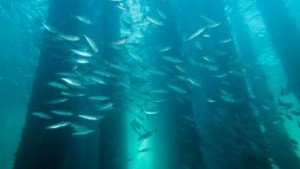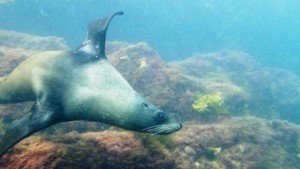Located about an hour and a half drive south of Adelaide, Fleurieu Peninsular presents South Australia with some incredible dives at a very convenient distance from the city by boat or by car.
Aldinga Drop Off
The Aldinga drop off is on the edge of the Aldinga reef lying 1.5 km off the Aldinga beach. Access is via boat which can be launched from the Southern end of Aldinga Beach or from O’Sullivan’s Beach ramp. The reef drops away from 5 m to 21 m creating a spectacular dive that is a mass of caverns, crevasses and overhangs. The reef is inside an aquatic reserve and fish abound making this a photographers paradise. The drop off is where the big schools of snapper stay when travelling north to their breeding grounds. When the snapper are running it is advisable not to dive this area as the snapper school is occasionally followed by white pointer sharks.
Aldinga Reef is also a breeding ground for Port Jackson sharks, and at the right time of year hundreds of sharks can be found under ledges resting between mating rituals.
Aldinga Pinnacles
Part of the Aldinga reef system closer in shore from the drop off. Spectacular dive with lots of swim throughs, overhangs, fish life and weed growth. The dive is in only 8m of water so an extended amount of time can be spent exploring the reef system, the overhangs and occasional cave. Visibility here is generally very good and swimming amongst rock pinnacles extending from the sea floor to just beneath the surface of the sea is very different to other SA dives. A great dive with no hazards and a recommended bottom time of 60 mins.
ExHMAS Hobart
 The ex HMAS Hobart was a Charles F. Adams class guided missile destroyer in the Royal Australia Navy (DDG 39), built in the United States of America and commissioned in 1965 in Boston. The vessel completed three tours of duty off Vietnam and in 1968, two sailors lost their lives and seven others were injured after the vessel was hit by “friendly” fire. The Hobart was sunk in November 2002 as an artificial reef and lies in 30 metres of water approximately 4 kms off Rapid Bay. Being 133.2 metres long and 14.4 metres wide this dive can take a several visits to explore completely. She now has plenty of fish life and growth over her and is fast becoming one of our most popular dive sites.
The ex HMAS Hobart was a Charles F. Adams class guided missile destroyer in the Royal Australia Navy (DDG 39), built in the United States of America and commissioned in 1965 in Boston. The vessel completed three tours of duty off Vietnam and in 1968, two sailors lost their lives and seven others were injured after the vessel was hit by “friendly” fire. The Hobart was sunk in November 2002 as an artificial reef and lies in 30 metres of water approximately 4 kms off Rapid Bay. Being 133.2 metres long and 14.4 metres wide this dive can take a several visits to explore completely. She now has plenty of fish life and growth over her and is fast becoming one of our most popular dive sites.
Due to its location the best time to dive this wreck is on a dodge tide due to strong currents that travel through the area at other tides.
Access is by boat from Sunset Cove boat ramp and a permit system applies. To obtain a permit visit: http://www.exhmashobart.com.au/dive/dive.html
Lasseter's Reef, Second Valley
Entry off the beach at Second Valley and head North from the centre of the beach for approximately 300 m, there you will discover a 50 m diameter dome shaped reef. A wide range of residents including the illusive Leafy Sea Dragon. The site is very exposed and not diveable in a big swell. Other shore dives in the area are behind the boat sheds and some small caves west of the sheds. The Jetty is used extensively as an open water training site.
Rapid Bay Jetty
 This is one of the best jetty dives in Australia, with lots of growth on the pylons and huge numbers of fish under and around the jetty. Access is from the shore over the rocks or by boat from Wirrina Cove boat ramp. There are schools of Trevally, Morwong, Yellowtail, Tommy Ruff, Old Wife and other common species. Very large Dusky Morwong are common, as are the wonderful Gurnard Perch and other hidden finds. The real special thing about the jetty, is the high likelihood of a sighting of the Leafy Sea Dragon. The more common Weedy Sea Dragon is also very often found here. There is usually plenty for those interested in the little critters which inhabit the nooks and crannies..
This is one of the best jetty dives in Australia, with lots of growth on the pylons and huge numbers of fish under and around the jetty. Access is from the shore over the rocks or by boat from Wirrina Cove boat ramp. There are schools of Trevally, Morwong, Yellowtail, Tommy Ruff, Old Wife and other common species. Very large Dusky Morwong are common, as are the wonderful Gurnard Perch and other hidden finds. The real special thing about the jetty, is the high likelihood of a sighting of the Leafy Sea Dragon. The more common Weedy Sea Dragon is also very often found here. There is usually plenty for those interested in the little critters which inhabit the nooks and crannies..
Rapid Head
 Access to this site is by beach launch at Rapid Bay or by boat ramp from Sunset Cove Marina. Great reefs and caves with plenty of see grass camouflaging a vast array of marine life. Large variety of fish including leafy sea dragons, blue devils and the occasional cray fish.
Access to this site is by beach launch at Rapid Bay or by boat ramp from Sunset Cove Marina. Great reefs and caves with plenty of see grass camouflaging a vast array of marine life. Large variety of fish including leafy sea dragons, blue devils and the occasional cray fish.
There is a local seal colony living off rocks nearby, so you will often be visited by seals during the dive.
The close proximity to Rapid Bay makes it a great double dive when combining the two.
The Star of Greece
The Star of Greece was built in Belfast in 1868 and was a 1227 ton, three masted ship. The ship ran aground just north of Port Willunga in the early hours of 13 July 1888 having left Port Adelaide the previous afternoon. A permanent bouy marks the wreck and access is by long walk and snorkel or by boat launched from the Southern end of Aldinga Beach or from O’Sullivan’s Beach ramp. Despite being wrecked only 200m from shore in 6m of water, only 10 of the crew of 27 survived. A mass headstone for the 17 crew members lost can be found at the Aldinga cemetary.
Being located in such a shallow location, the mast can be visiable at low tide. The wreck is sometimes covered in sand, so summer is the best time to find her with little sand and seaweed movement. She makes for a great snorkel, with plenty of parts of the wreck to see.
The Blowhole
This site is in Deep Creek Conservation Park 80 km south of Adelaide and is only accessible by four wheel drive. You need to follow the signs through the park, down the dirt road to the car park. Four wheel drive only from the car park down a very steep track to the end. Follow the steep walk/path several hundred metres to a small beach. Entry is anywhere from the beach. This is a beautiful unspoilt site. It is teeming with life, crays galore, seals and sea dragons. You do have to watch for heavy current and freak waves and its strongly advised you dive with someone who knows the area – at least at first.
The Bluff
The Bluff at Victor Harbour is an awesome dive in the right conditions. Entry is from the small wharf on the eastern side of the Bluff. Leafy sea dragons are often seen here. There are also seals, seahorses, weedy sea dragons, crayfish, nudibranchs, plus lots and lots of fish. The area is strewn with big granite boulders, stacked one on top of the other, with big holes, ledges, swim throughs, etc. In the holes are a big variety of sponge, and soft coral life, as well as the occasional nudibranch. Depth ranges from 4 m to 40 m
Caution, there can be tricky currents even on calm days and large waves can appear out of nowhere.
Whale Bones
Whale bones is in Encounter Bay at Victor Harbour. Follow the road to the bluff and turn off at the hospital. Whale bones is the reef in front of and to the right where this road meets the beach. Access is from shore over a 100 or so metres of knee deep water or by boat from the nearby Bluff boat ramp. This is a big system of limestone caves, undercuts, swim-throughs, and reef. It is a virtual honeycomb of caves, and passages. The top of the reef is only in about 2-3 metres of water, with lots of holes in the top, that lead down into the caves. If you head out to sea, you will also see a drop-off, which also leads into the caves. The site got its name from the fact that there used to be lots of whale bones in the area, as the whalers used to dump the whale carcasses in the area.
